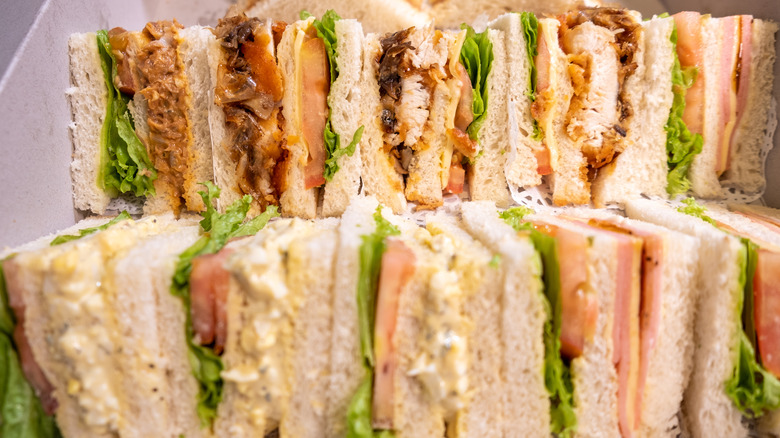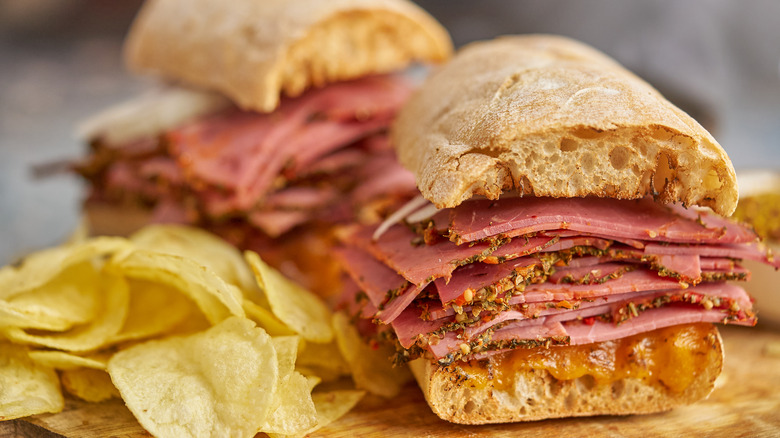Here's What Actually Counts As A Proper Sandwich
Few dishes have a format as straightforward as a sandwich. At its most fundamental, it's as simple as cooking gets — ready-to-eat foods like cured meats, cheese, and vegetables placed between two slices of bread. Yet, take a gander at sandwich recipes, and it's clear how many renditions can be attributed to such a template. The filling can be an elaborate cooked food, like sautéed fish or fried chicken. The doughy vessels can encompass dozens of bread types, although most maintain they should be of the leavened variety.
Many of the sandwich classics are undisputed — no one's gonna claim that a Reuben or sweet and savory club sandwich doesn't belong to the category. However, if you start to stray from the most quintessential examples, the definition becomes more controversial. According to the dictionary, hot dogs are sandwiches, although the National Hot Dog and Sausage Council proposes they've evolved out of the term, and Anthony Bourdain similarly took a stand on the hot dog sandwich debate.
And that's just the discussion regarding a singular sandwich adjacent dish; what about burgers, kebabs, pizza, and even tacos? Well, there are arguments to be made for both sides, with the sandwich's most essential nature revealed in the process.
A sandwich consists of two bread slices for portability
With their utilitarian simplicity, sandwich-like foods are hardly a new invention, with the first printed version dating to the first century B.C. Yet the name sandwich only traces back to 17th century Britain. A popular legend claims that the "Earl of Sandwich" is the British aristocrat behind the term. As the story goes, he requested salt beef between bread slices so he could eat without leaving the card table.
Although the name sandwich likely predated the tale, the account reveals a central quality: the food is built for portability. And the two slices of bread are the fundamental vessel for such functionality. Those exterior slices make it easy to transport and eat the food wherever. It's why PB&J's will forever be a popular lunchbox item and the reason popular Jimmy John's sandwiches remain an office delivery favorite.
Such a two-slice build disqualifies toasts, and accordingly, few will say that avocado toast is a sandwich. Plus, open-faced creations like Scandinavian smørrebrød don't fit the criteria, although these foods are seldom eaten on the move. This excludes many other foods with one piece of bread, like lobster rolls, hot dogs, and Philly cheesesteaks, out of proper sandwich criteria. A contentious topic, some may deem them as exceptions that nevertheless fit into the categorization. Or, perhaps, they're creations that have spun off enough to leave the sandwich moniker entirely. After all, a burger fits sandwich parameters, but it's so distinct that most will place it in a class of its own.
Sandwiches are made with Western-style leavened bread
Nowadays, sandwiches exist in global culinary contexts, from Vietnam's banh mi to Mexican tortas and South African spatlos. Despite their varied origins, all these creations have a common thread: they're made with leavened bread. Such compositions with puffier doughs stem from the fact that sandwiches first caught the trend in Europe, specifically in the U.K., where such a style of dough creation is the norm. As a result, when you picture a sandwich creation across cuisines, it's probably a medley of local components jammed between a European-influenced baked good.
That's not to disregard tacos, pitas, arepas, or dosas from the conversation. After all, some suggest early European sandwich creations were inspired by Turkish kebabs. Rather, it's that the sandwich concept stems from a European background, so why conglomerate such varied and complex foods into one umbrella?
The nixtamalization necessary to form tortillas has been around well before European arrival, and the fascinating ancient history of pita traces back over 10,000 years ago. Such foods have a history that reaches further back than the concept of a sandwich, so they represent unique categories in themselves. It's not a matter of exclusion, but rather a celebration of culinary diversity. And no matter what you call it, it's bound to be delicious, so there's always room for an opposing point of view, too.


